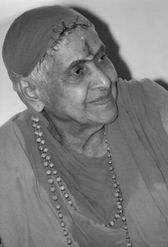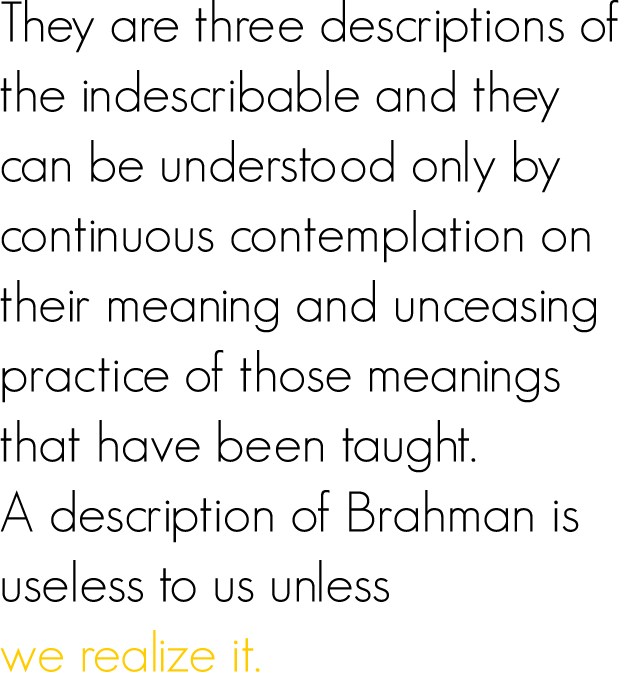

There are many meaning for the word Upanishad. Etymologically it can be explained as sitting (sad) close by (upa) with devotion (ni). Practically this is also right. One who stays close to the Guru with devotion hears and learns a great deal if he or she has devotion. If the aspirant has no devotion, then no amount of attendance on the Guru will bring him or her knowledge. There are two ways in which the knowledge of the Sastras becomes enriched with the Guru’s teaching and comes to us. Either one may come to Sri Sathguru filled with the knowledge of the Sastras, then we find new and more appropriate meanings to the words of the Sastras when we hear Sri Sathguru’s words and observe Her actions. The other way is for those who have been fortunate to spend many years especially at an early age with the Guru. When they read the Sastras they will find it reminiscent of the teachings of the Guru and find see the guru and the Guru’s teachings in a new light. When we read the Upanishads we found the reasons for many of Sri Sathguru’s actions and words that had puzzled us earlier.
For instance the Upanishads tell us that during a sacrifice the main priest should speak no words. He should use gestures and if he wishes to say “yes” he should say Om. When we read this we remembered Sri Sathguru’s mien during a puja. Even if it was the daily prayer, Sri Sathguru did not speak a word till it was over, even the most important question would not be answered. Similarly Sri Sathguru was speaking about the lack of faith today in the spiritual life. Sri Sathguru said, “Most people believe in God and Dharma. This is because they know in their hearts that these exist. All that we see around us is dependent for its existence on God and Dharma. Why then is it that people are not interested in spiritual teachings? It is partly because of the materialistic atmosphere that exists today and partly because the preachers have no realization. It is not that God expects everyone who gives discourses to be Jivan muktas, but that there must be a modicum of realization and it should be done only as an offering to God, as a means to realize Him. But when the teacher is interested only in fame or in wealth, the disciple senses it and does not make his best effort to reach God.”
This reminds us of the mantra in the Taittirya Upanishad,
Om iti Brahmana pravaksyannaha brhamhopaapnavaaniiti. Brahmai vo paapnoti.
(When a Brahmana about to recite the Vedas does so reciting Om with the intention of attaining Brahman, he verily attains Brahman.)
This is how all learning should be received or given, with the intention of self- development not self-aggrandizement.
When a teacher is a srotriya Brahmanishta, then all actions, all words are a teaching. All actions and all words of such a person transform the disciple, like Rahugana were transformed by his meeting with Jadabharata, or Vaivaswata Manu was transformed by the teachings of his family Guru. There are many instances of how Sri Sathguru has enlightened disciples on various truths of the Sastras by Sri Sathguru’s actions or words. The greatest teachings from a Guru who is established in the Self are always given unpretentiously since the aim is to uplift the seeker and not promote the speaker of these truths. Once after hearing the recitation of the Taittirya Upanishad, Sri Sathguru said, “Do you know how profound the words Satyam Gnanam anantham Brahma is? It is not just three concepts to be commented and argued upon. They are three descriptions of the indescribable and they can be understood only be continuous contemplation on their meaning and unceasing practice of those meanings that have been taught. A description of Brahman is useless to us unless we realize it. These teachings have two aspects, one the philosophical nature of the truth; the second is the transforming nature of the truth. Once one has understood a Tattva one will not be deluded again. ”Sri Sathguru then explained the meaning of the words.
Om Brahmavidaapnoti param tadesaabhyuktaa
Satyam gnanam anantham brahma.
Yo veda nihitam guhaayaam parame vyoman.
Soshnute sarvaan kaamaan saha.
Aum. The Knower of Brahman reaches the Supreme. As to this it has been said, he who knows that Brahman is Existence, Knowledge and without an end hidden in his heart as well as in the highest heaven realises all his desires along with Brahman.
The Upanishads tells us that Brahman is Satyam, Existence, Gnanam, Knowledge and Anantam, infinite, unending. What does it mean to us that Brahman is Existence, Knowledge and without an end? How does it affect our lives?
When we say that Brahman is Satyam we mean that it is both Existence but also that it is Truth. You may say that we believe in God’s existence, that He is omniscient, all pervading etc but do you really believe it in your hearts, do you practise it? If you really believe that God is with us always, can you even think of doing anything wrong? If you think of Him as Truth, can you even think of telling a lie?
Brahman is knowledge. Consider your actions, how many of them spring from clear thought, from a sense of right and wrong. How many of them are desire-driven, anger- driven, fear-driven, and how many are caused by peer pressure, a desire to keep up with others, and because everyone does it. Are you doing it because you think it is right or do you say that it is right because you want to do it?
When you know that God really exists and that He is Truth itself, then you are transformed, you do what you have to do for His sake.. Because you feel it should be done. Because you believe that you should do it and not because you have to do it or because you want to do it. That Knowledge transforms you.
And then you see that Brahman is unending eternal and infinite. While now you think that you, the little “you”, with its little concerns, your body and your small self is eternal, and it is and without an end. Your hopes, your joys, your sorrows, your dreams, your disappointments, you think that they are eternal. But they are not. Only Brahman is Eternal, without an end. Everything else, which is finite, will pass away. As long as you mistake the Shadow for the Substance, you will suffer sorrow and disappointments.
But when you know that Brahman is Satyam, that He alone exists, that Brahman is the only Truth, then that Knowledge which is also Brahman, transforms you, you know that Brahman is alone eternal, that all fears, sorrows, joys, hopes and suffering pass away like clouds which momentarily cover the sun. Which is why it is said that the knower of Brahman attains the Highest for what can be higher than this knowledge which transforms the whole person, “he knows this hidden in his heart as well as the Highest Heaven” he knows that the principle of Brahman being Existence, Knowledge and Infinite without an end, is true not only as a principle which to be contemplated as in the highest heaven but also something which can be practiced here in this world and realised, here while in this body. Such a person realises Brahman and since his being is what Sri Krishna calls “Brahman-become” all his desires are God’s desires and are automatically fulfilled.
NARAYANA
